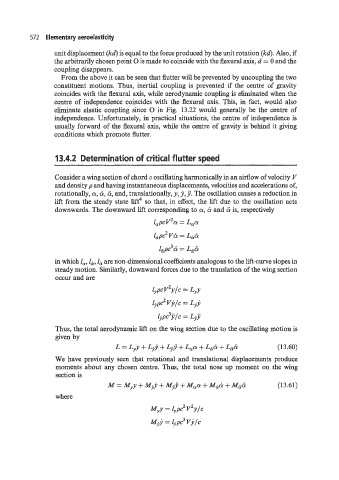Page 591 - Aircraft Stuctures for Engineering Student
P. 591
572 Elementary aeroelasticity
unit displacement (kd) is equal to the force produced by the unit rotation (kd). Also, if
the arbitrarily chosen point 0 is made to coincide with the flexural axis, d = 0 and the
coupling disappears.
From the above it can be seen that flutter will be prevented by uncoupling the two
constituent motions. Thus, inertial coupling is prevented if the centre of gravity
coincides with the flexural axis, while aerodynamic coupling is eliminated when the
centre of independence coincides with the flexural axis. This, in fact, would also
eliminate elastic coupling since 0 in Fig. 13.22 would generally be the centre of
independence. Unfortunately, in practical situations, the centre of independence is
usually forward of the flexural axis, while the centre of gravity is behind it giving
conditions which promote flutter.
13.4.2 Determination of critical flutter speed
Consider a wing section of chord c oscillating harmonically in an airflow of velocity V
and density p and having instantaneous displacements, velocities and accelerations of,
rotationally, a, d!, &, and, translationally, y, j, 9. The oscillation causes a reduction in
lift from the steady state lift4 so that, in effect, the lift due to the oscillation acts
downwards. The downward lift corresponding to a, d! and & is, respectively
1,pcv2a = L,a
lbPC2Vd! = L&&
I.. c3& = L&&
CYP
in which I,, I&, lii! are non-dimensional coefficients analogous to the lift-curve slopes in
steady motion. Similarly, downward forces due to the translation of the wing section
occur and are
IypcV2y/c = Lyy
Ijpc2vj/c = Lyj
I.. c3 " c - L *-
yP Yl - yY
Thus, the total aerodynamic lift on the wing section due to the oscillating motion is
given by
L = Lyy + LyJj + Lyy + L,a + L&d! + L&& (1 3.60)
We have previously seen that rotational and translational displacements produce
moments about any chosen centre. Thus, the total nose up moment on the wing
section is
M = Myy + Myj + Mjj + M,a + Mbd! + Mcii (13.61)
where
Myy = lypc2 V2y/c
~~j = iypc3 v$lc

